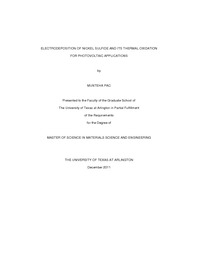| dc.description.abstract | Alternative photovoltaic materials that feature natural abundance, low extraction and processing costs, and reasonable efficiency have to be found. In this respect, transition metal chalcogenides such as oxide and sulfide compounds of Ni; is studied because in addition to the features like abundance and cost, its electronic and optical properties vary dramatically by modifications in its stoichiometry. In addition to its low cost, and mature technology, electrochemical deposition method has many advantages over other methods since it allows direct deposition on conducting substrate and achieves good electrical contact and precise control of film thickness. Process of manufacturing Nickel Oxysulfide compound consisted of two steps. First, the effect of deposition parameters on film uniformity and adhesion to FTO (fluorine-doped tin oxide) substrate has been investigated. These deposition parameters include gelatin as an additive to stabilize colloidal S [5], the ratio of Ni precursor (NiSO4) and to S precursor (Na2S2O3), and pH and temperature of the deposition solution. Solution stability is measured by zeta potential. Sulfur particles size is determined by DLS. With addition of 8.8×10-4 wt% gelatin in the deposition solution, the size of S particles was found to be ~250 nm. This eliminates the instability of the solution under acidic pH due to coagulation and flocculation of colloidal S which causes poor uniformity and weak adhesion. In terms of deposition rate and film uniformity, the precursor ratio (Ni/S), pH, and temperature were found to be optimal at 0.013, 4.7, and 60°C, respectively. XRD is used to determine crystalline phases that constitute film. Only Ni3S2 was observed. In conclusion, the deposition solution is stabilized with gelatin and deposition parameters are optimized, leading to a uniform and adhesive Ni3S2 thin film on FTO substrate for photovoltaic applications.Finally, after Ni3S2 film deposition with desired properties, the thermal oxidation of films at different temperatures is studied. Oxidation at 500- 550°C is found to be a temperature where Nickel sulfide film turned to two phases. These phases are Nickel Oxysulfide with an unknown stoichiometry and semiconducting Nickel Oxide. | en_US |

